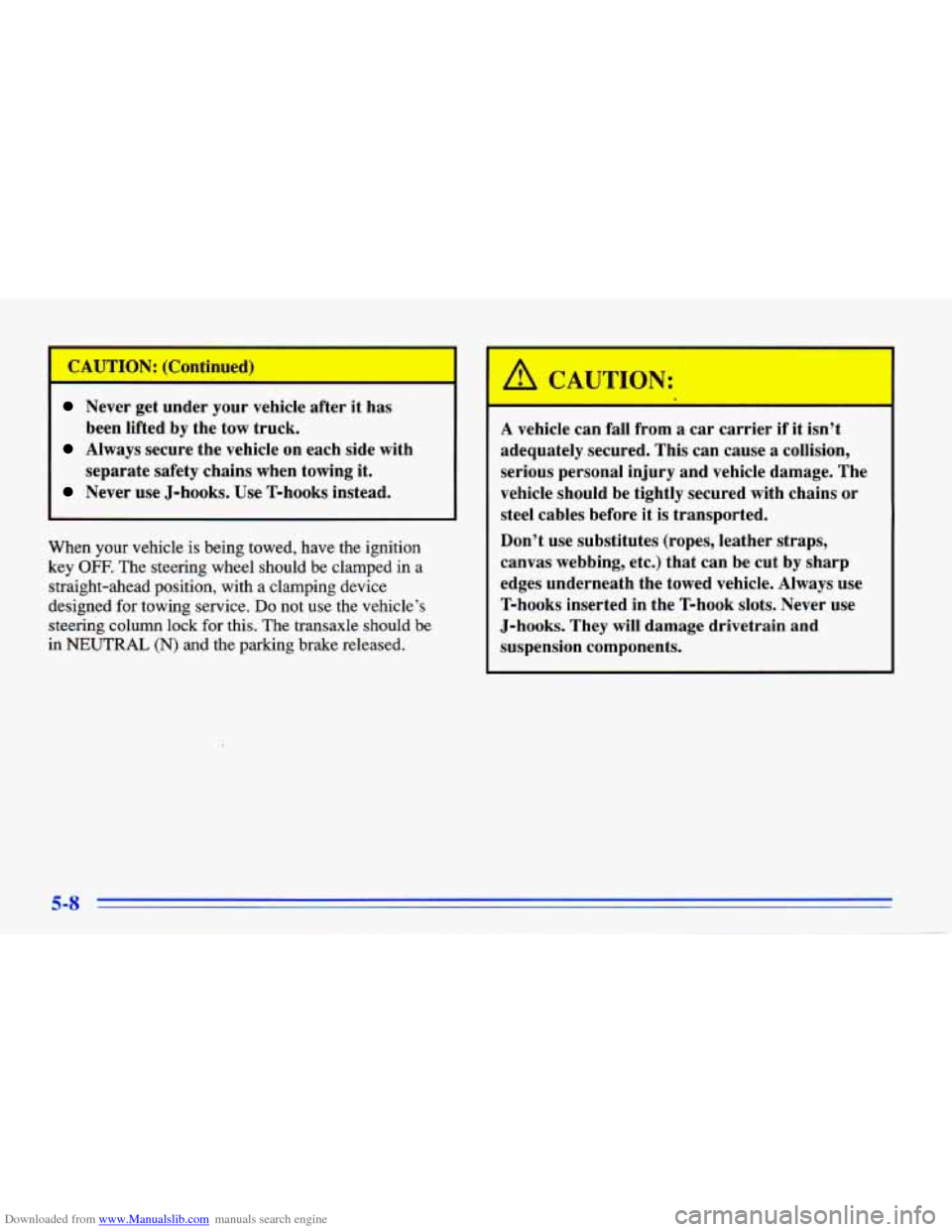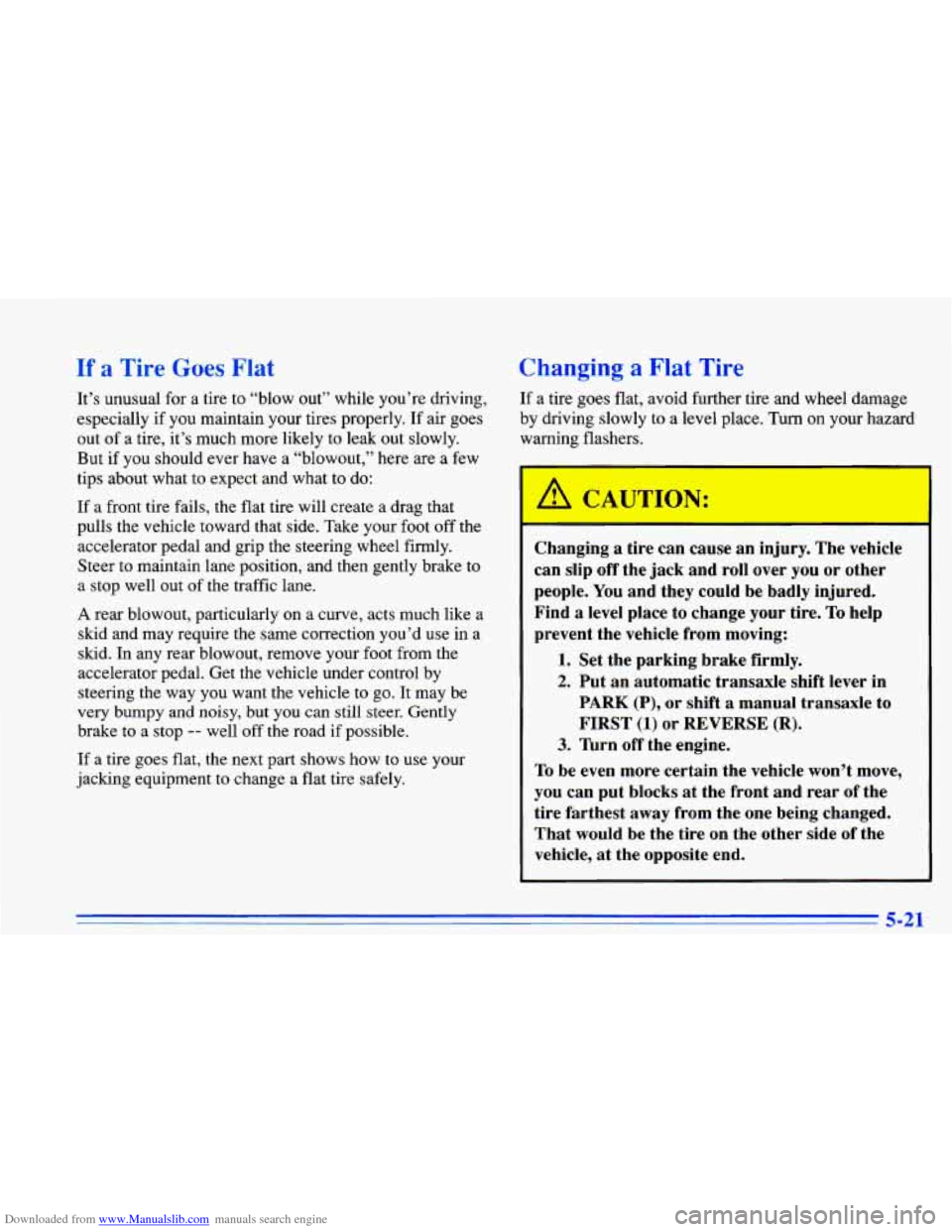Page 212 of 372

Downloaded from www.Manualslib.com manuals search engine -- IO Iontinut I I
Never get under your vehicle after it has
been lifted by the tow truck.
Always secure the vehicle on each side with
separate safety chains when towing it.
Never use J-hooks. Use T-hooks instead.
When
your vehicle is being towed, have the ignition
key OFF. The steering wheel should be clamped in a
straight-ahead position, with a clamping device
designed
for towing service. Do not use the vehicle’s
steering column lock for this. The transaxle should be
in
NEUTRAL (N) and the parking brake released.
A CAUTION:
I
A vehicle can fall from a car carrier if it isn’t
adequately secured. This can cause
a collision,
serious personal injury and vehicle damage. The
vehicle should be tightly secured with chains or
steel cables before it is transported.
Don’t
use substitutes (ropes, leather straps,
canvas webbing, etc.) that can be cut by sharp
edges underneath the towed vehicle. Always use
T-hooks inserted in the T-hook slots. Never use
J-hooks. They will damage drivetrain and
suspension components.
5-8
Page 213 of 372
Downloaded from www.Manualslib.com manuals search engine Front Towing
Before hooking up to a tow truck, be sure to read all
the information in “Towing Your Vehicle” earlier in
this section. Attach T-hook
chains into the
slots in the bottom of the
floor pan, just behind the front wheels, on both
sides.
These slots are to be used when loading and securing to
car carrier equipment.
5-9
Page 214 of 372
Downloaded from www.Manualslib.com manuals search engine NOTICE:
Do not tow with sling-type equipment or
fascia/fog lamp damage will occur. Use wheel-lift
or car carrier equipment. Additional ramping
may be required for car carrier equipment. Use
safety chains and wheel straps.
Towing
a vehicle over rough surfaces could
damage
a vehicle. Damage can occur from vehicle
to ground or vehicle to wheel-lift equipment. To
help avoid damage, install a towing dolly and
raise vehicle until adequate clearance
is obtained
between the ground and/or wheel-lift equipment.
Do not attach winch cables or J-hooks to
suspension components when using car carrier
equipment. Always use T-hooks inserted in the
T-hook slots. Attach a separate safety chain around
the outboard
end
of each lower control arm.
5-10
Page 215 of 372
Downloaded from www.Manualslib.com manuals search engine Rear Towing
Towing dolly required underfiont wheels when equipped
with automatic transaxle
or damage will occur.
Attach T-hook chains on both sides in the slotted holes
in the bottom of the frame rail, just ahead of the rear
wheels. These slots are to be used when loading and
securing to car carrier equipment.
Before hooking up
to a tow truck, be sure to read all the
information in “Towing Your Vehicle” earlier in this
section,
Also be sure to use the proper hook-up for your
particular vehicle. Place
the front wheels on
a towing dolly or place the
vehicle on a car carrier.
5-11
Page 216 of 372
Downloaded from www.Manualslib.com manuals search engine NOTICE:
Do not tow your Cavalier from the rear with
the front wheels on the ground or your transaxle
can be damaged.
Do not tow with sling-type equipment or rear
fascia will be damaged.
Use wheel lift or car
carrier equipment. Additional ramping may be
required for
car carrier equipment. Use safety
chains and wheel straps.
Towing
a vehicle over rough surfaces could
damage
a vehicle. Damage can occur from vehicle
to ground or vehicle to wheel-lift equipment. To
help avoid damage, install
a towing dolly and
raise vehicle until adequate clearance is obtained
between the ground and/or wheel-lift equipment.
Do not attach winch cables or J-hooks to
suspension components when using car carrier
equipment. Always use T-hooks inserted in the
T-hook slots.
A
I I
Attach a separate safety chain to each side of the axle
inboard of the rear shock absorber attachment.
(Do not
use the chain as a
tie down.)
5-12
Page 218 of 372

Downloaded from www.Manualslib.com manuals search engine If No Steam Is Coming From Your Engine
If you get the overheat warning but see or hear no
steam, the problem may not be too serious. Sometimes
the engine
can get a little too hot when you:
Climb a long hill on a hot day.
Stop after high-speed driving.
Idle for long periods in traffic.
Tow a trailer.
If you get the overhear warn J wlm no sign of steam,
try this for a. minute or
so:
1. If you have an air conditioner, turn it off.
2. Turn on your heater to full hot at the highest fan
speed and open the window as necessary.
3. If you’re in a traffic jam, shift to NEUTRAL (N);
otherwise, shift to the highest gear while
driving
-- AUTOMATIC OVERDRIVE (D)
or THIRD (3) for automatic transaxles.
If you no longer have the overheat warning, you can drive.
Just to be safe, drive slower for about
10 minutes. If the
warning doesn’t come back on, you can drive normally.
If the warning continues, pull over, stop,
and park your
vehicle right away.
If there’s still no slgn of steam, you can idle the engine
for two or three minutes while you’re parked, to see if
the warning stops. But then, if you still have the
warning,
turn ofthe engine and get everyone out of the
vehicle until it cools down.
You may decide not to lift the hood but to get service
help right away.
When you decide it’s safe to lift the hood, here’s what
you’ll see:
2.2L
Engine
5-14
Page 225 of 372

Downloaded from www.Manualslib.com manuals search engine If a Tire Goes Flr Changing a Flat Tire
It’s unusual for a tire to “blow out” while you’re driving,
especially if you maintain your tires properly.
If air goes
out of a tire, it’s much more likely to leak out slowly.
But if you should ever have a “blowout,”
here are a few
tips about what to expect and what to do:
If a front
tire fails, the flat tire will create a drag that
pulls the vehicle toward that side. Take your foot off the
accelerator pedal and grip the steering wheel firmly.
Steer to maintain lane position, and then gently brake to
a stop well out of the traffic lane.
A rear blowout, particularly on a curve, acts much like a
skid and may require the same correction you’d use in a
skid. In any rear blowout, remove your foot from the
accelerator pedal. Get the vehicle under control by
steering the way you want the vehicle to
go. It may be
very bumpy and noisy, but you can still steer. Gently
brake
to a stop -- well off the road if possible.
If a tire goes flat, the next
part shows how to use your
jacking equipment to change a flat tire safely.
If a tire goes rlat, avoid further tire and wheel damage
by driving slowly to a level place. Turn on your hazard
warning flashers.
I
Changing a tire can cause an injury. The vehicle
can slip
off the jack and roll over you or other
people. You and they could be badly injured.
Find
a level place to change your tire. To help
prevent the vehicle from moving:
1. Set the parking brake firmly.
2. Put an automatic transaxle shift lever in
PARK (P), or shift a manual transaxle to
FIRST
(1) or REVERSE (R).
3. lbrn off the engine.
To be even more certain the vehicle won’t move,
you can put blocks
at the front and rear of the
tire farthest away from the one being changed.
That would be the tire on the other side of the
vehicle,
at the opposite end.
5-21
Page 231 of 372
Downloaded from www.Manualslib.com manuals search engine 6. Remove all of the wheel nuts.
7. Remove the wheel cover from the wheel, if your
vehicle has them. Then remove the flat tire.
8. Remove any rust or dirt
from the wheel bolts,
mounting surfaces and spare wheel.
A CAUTION:
I- -
Rust or dirt on the wheel, or on the parts to which
it is fastened, can make the wheel nuts become
loose after
a time. The wheel could come off and
cause an accident. When you change
a wheel,
remove any rust or dirt from the places where the
wheel attaches to the vehicle. In an emergency, you
can use
a cloth or a paper towel to do this; but be
sure to use
a scraper or wire brush later, if you
need to, to get
all the rust or dirt off.
5-27